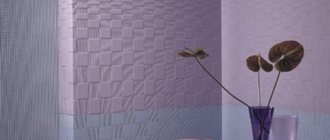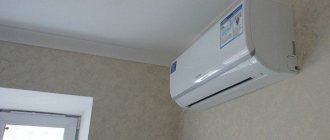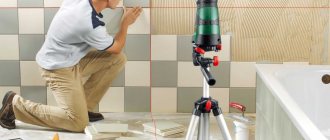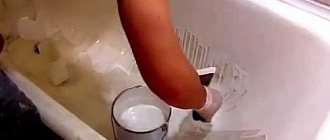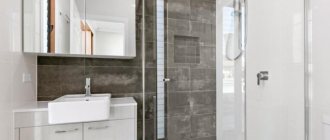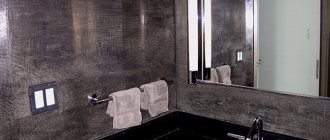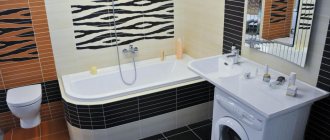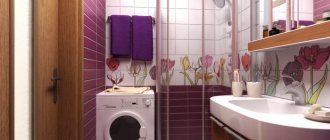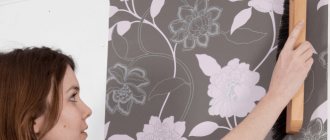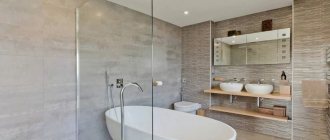What kind of wallpaper can be glued in the bathroom?
Washable
They are produced on different bases, protected with a special moisture-resistant composition. The reverse side of the canvas has good adhesion, which simplifies installation even on concrete, paint and plaster. Wallpaper is durable and wear-resistant. They are easy to clean with a damp cloth or brush.
Tip: on the packaging of the most mechanically and moisture-resistant specimens, three wavy lines and a brush are indicated.
Bright washable wallpaper in the bathroom
The disadvantages of washable wallpaper include low vapor permeability, so you need to ensure high-quality ventilation and airing in the bathroom. With frequent washing, the surface of the wallpaper loses its original appearance. The optimal solution is to choose canvases with a calm color scheme .
Washable wallpaper with a metallic sheen
Washable wallpaper is easy to care for
Vinyl
Their secret is polyvinyl chloride, which covers their outer layer and protects them from high temperatures and moisture. This is an environmentally friendly and safe material with antifungal components in its composition. Wallpapers are produced on paper and non-woven bases. The durable structure of vinyl is easy to glue, lasts a long time and withstands mechanical stress, including washing with cleaning agents.
Tip: for slightly uneven walls, choose foam or embossed vinyl - silk-screen wallpaper will only highlight the imperfections.
Textured vinyl wallpaper for modern interiors
Particularly wear-resistant and durable are multi-layer polyfiln, foam and hard vinyl. The last of the types is capable of removing harmful substances from the walls. Among the disadvantages of this type of finishing are the high price and the need to use a special adhesive for vinyl wallpaper .
Vinyl wallpaper with floral pattern
After applying regular glue, the vinyl sheets stretch, and after drying, they shrink. Specialized glue prevents this deformation.
Due to the light shades, the pattern on the wallpaper does not dazzle the eyes
Liquid
With them you can create unique designs, emphasizing the individuality of the bathroom design. They are based on a mixture of cellulose fibers, textile materials and adhesive components. After adding water it resembles plaster. Due to its ability to dry quite quickly, the mixture must be applied quickly and evenly. But the high breathability of the wallpaper prevents the mirrors from fogging up.
Terracotta wallpaper complements the earthy palette in the bathroom interior
One of the obvious advantages of liquid wallpaper is the ability to easily and quickly eliminate defects on its surface (it is enough to cover them with fresh mixture). It is recommended to apply them at a temperature not exceeding 15º C.
Tip: to use this coating in the bathroom, it is advisable to treat it with acrylic varnish to enhance protection against moisture.
Liquid wallpaper adds texture to the wall
The dense structure of the mixture has heat and sound insulation properties. But care with abrasive products is not suitable for this wallpaper.
The highlight of the decor is an exquisite pattern on liquid wallpaper
Decorative plaster
If he talks about new finishing materials for the bathroom, then first of all it’s worth remembering decorative plaster. It can be applied to relatively flat walls or to a plastered surface. Usually they prefer to first level the walls, then apply decorative plaster. It is an expensive material, so it is advisable to minimize consumption.
Venetian plaster coated with two layers of wax
For finishing bathroom walls, moisture-resistant options are chosen, and these are mainly façade compositions. They do not change color for a long time, they can be washed with a hard brush and detergent, but they are very rough to the touch. Options for finishing a bathroom with facade plasters are shown in the photo below.
One of the options for finishing a bathroom is Venetian plaster, coated with two layers of wax. With this combination of materials, water in any form simply rolls off it. In terms of practicality, this option is no worse than paint, but definitely more beautiful. Disadvantages: high price and difficulty of application.
Read about methods of applying decorative plaster here.
Pros and cons of decorating bathroom walls with wallpaper
A small bathroom is an ideal place to experiment with wallpaper. They make it easy and quick to add color, texture and unique character to your interior. Here are some more of their advantages:
- wide selection of colors, prints, textures and patterns,
- accessibility and speed of installation - it is not necessary to involve specialists,
- the ability to combine with other materials and save money on finishing (you can reduce the number of tiles or panels),
- ease of dismantling (unlike, for example, tiles), which makes it easy to change the decor in the bathroom,
- the ability to imitate expensive finishing materials (granite, marble, wood).
The golden hue of the mirror frame is played up in the wallpaper design
Bathroom in eco-style with winning accents due to colorful wallpaper
Disadvantages of using wallpaper in the bathroom:
- over time, a coating of dirt and dust forms on the wallpaper, so it is advisable to regularly and carefully clean its surface;
- wallpaper is sensitive to deep and rough cleaning with a wire brush and chemicals - if it is heavily soiled, it is easier to change it than to clean it;
- the risk of peeling and cracking in wallpaper is slightly higher than in tiles, especially in new buildings when shrinkage of the house has not yet been completed;
- with poor ventilation and airing in the bathroom, mold and mildew quickly appear on the wallpaper,
- Regular wallpaper adhesive for water-repellent wallpaper will not work - you need to purchase a special water-resistant one.
Tip: if you are in doubt about using wallpaper in the bathroom, then try stencils for walls that imitate patterns on wallpaper.
Light wallpaper requires regular and careful care
Conclusions on the topic
What wallpaper should I put in the bathroom? The choice is up to the owner of the premises. They can be anything, the main thing is to choose a moisture-resistant option. Such a coating will not only be attractive, but also functional, and, most importantly, inexpensive. Buying wallpaper will not empty the family wallet, and you can paste the panels yourself.
Therefore, many choose wallpaper to decorate their bathroom, despite the fact that such a decision seems absurd. A wide range of wallpaper allows you to choose the best option for any room style. At the same time, changing the interior decor will be very simple - you just need to replace the wallpaper.
Installation features
Places for gluing
It is important not only what wallpaper will be chosen for the bathroom, but also where it will be pasted. Experts advise against doing this directly in wet areas where there is direct and constant contact with water (in the shower, around the edge of the bathtub, or behind the sink). Leave these spaces for more practical tiles or panels.
Variegated prints instantly liven up a monochrome finish
A fashion trend is an accent wall opposite the sink or bathtub for dramatic contrast and depth.
There can be several accent walls
Conditions for application
The key conditions for using wallpaper in the bathroom are high-quality ventilation and regular airing (if the room has a window, even better). Before gluing you must:
- make sure that the batch number, shade and patterns on all rolls match,
- prepare a special waterproof glue with an antifungal effect,
- clean and level the surface of the walls, sanding cracks and glossy areas,
- treat the walls with an anti-mold primer for wallpaper in 1-2 layers.
Tip: in areas near wet areas, it is advisable to apply additional glue to the wallpaper.
To glue wallpaper in the bathroom you need to choose a special waterproof adhesive
Care Tips
After the wallpaper has completely dried, you can coat it with a special clear varnish to enhance protection against moisture, heat and stains. It comes in both matte and glossy finishes.
A bathroom with wallpaper needs good ventilation.
When taking a shower, it is advisable to turn on the fan in the bathroom so that steam and moisture do not settle on the wallpaper. You can leave the windows or bathroom door slightly open during and after bathing. Remove dust and dirt from the wallpaper weekly or every two weeks using a soft, slightly damp cloth or sponge .
Tip: To clean wallpaper, prepare a solution of two tablespoons of dishwashing detergent and three glasses of warm water.
Do not forget to periodically clean the wallpaper from dust and dirt.
Painting
Painting is a traditional way of decorating walls in wet rooms, almost forgotten for some time due to the impracticality and unattractiveness of the resulting coating. The paint was only oil, the walls were not very smooth (to put it mildly), and in general the appearance was poor. New technologies and materials make it possible to achieve a perfectly smooth surface, a variety of colors - different effects. All this at low cost. This is gradually reviving a forgotten option for finishing a bathroom - painting the walls.
Preparing the walls
A perfectly flat surface is required for painting and it can be made this way using moisture-resistant putty. It can be applied to plaster or drywall. Regardless of the base, with sufficient skill, the surface becomes truly ideal. Not a single flaw - it's possible.
The surface to be painted must be perfect
The prepared walls or ceiling are primed with a composition with an antibacterial and water-repellent component; after drying, you can begin to apply paint.
Types of Bathroom Paints
But not all paints can be used in the bathroom, since not all of them are moisture resistant. The following paints and varnishes are suitable:
- Water-based paints based on latex and acrylates. Acrylic water emulsion is an inexpensive option that can withstand high humidity, but it should not be used in close proximity to a bathtub, shower or washbasin. Latex emulsion forms a dense waterproof film on the surface and even slightly “tightens” unevenness, if any. See how to paint walls with water-based paint here.
- Alkyd paints. In appearance they are very similar to oil ones, but have better characteristics, they can be glossy, semi-glossy, matte. Among the advantages - it has average vapor permeability and low price. Disadvantages - emphasizes all the irregularities, changes color over time - acquires a yellowish tint. Another drawback is that they are made on the basis of organic solvents (white spirit, gasoline, turpentine), so the smell is strong before drying.
- Silicate paints. The main advantage is that fungus or mold will not appear on walls and ceilings painted with this paint. There are also advantages: very high vapor permeability, strong and durable coating. Disadvantage: until the composition has dried, it is very harmful to humans. As soon as crystallization has occurred, the coating becomes absolutely harmless, but you must work in protective clothing and a respirator and leave the house before it dries. Another unpleasant point: no other paints “stick” to silicate paints. If you want to change the type of paint, you will have to clean everything off.
- Based on silicones. This compound is 100% waterproof. It does not conduct water in any form - in the form of steam either. Therefore, when finishing with this type, you will have to do very powerful ventilation.
- Chlorinated rubber. Paints of this type are used in swimming pools to paint bowls, so they are even suitable for walls near the bathtub or shower stall. But you will also have to take care of good ventilation and removing the coating before the next painting.
As you can see, there are many options for finishing a bathroom with paint. Most can be used on a limited renovation budget, but chlorinated rubber and silicone are not very cheap.
Color palette
Wallpaper should go well with the decoration of windows, floors and furniture. To do this, repeat one or more shades of the overall decor using wallpaper. When in doubt about successful combinations, use the color wheel.
Tip: when choosing colors, it is advisable to adhere to the rule: 60% primary color, 30% secondary color and 10% accent shades (2-3).
Silver wallpaper fits harmoniously into the overall palette of the Empire style bathroom
If the furniture in the bathroom is light, choose bright colors of wallpaper that will lift your mood. For dramatic contrast, use an accent shade as the main wallpaper color. Beware of too dark canvases over pastel tiles, unless you are deliberately going for a "flip" effect .
Important: the “light above and dark below” approach is similar to the natural combination (sky-trees-earth), which provides “visual gravity” - a natural feeling of “grounding”.
A multi-colored wallpaper pattern on a white background sets an energetic rhythm to the interior and improves your mood.
Wallpaper with small patterns does not disturb the neutral color scheme of the interior
For small bathrooms overloaded with furniture, plain neutral wallpaper or with a small amount of light patterns is suitable. They don't weigh down the space.
Selection of pattern and texture
It is no longer relevant to look for a wallpaper pattern that fits the dimensions of the room. A large pattern on wallpaper in a small bathroom can be an effective design solution without visually reducing the space. Just choose a lighter background for the picture.
The color of the pattern on the wallpaper matches the overall palette in the bathroom
A small bathroom with poor natural light is an ideal candidate for shiny metallic wallpaper that deepens the reflective light. Horizontal stripes on wallpaper will make the wall appear longer, while vertical stripes will create the illusion of height.
Photo print with tall trees visually increases the ceilings in the room
Combining wallpaper with other finishing materials
Mono-finishing of a bathroom with wallpaper is possible, but with obligatory observance of ventilation conditions and additional protection of the canvases from moisture. A more practical option is to combine wallpaper with other types of materials.
Wallpaper and tiles
The most popular way is to tile on the bottom half of the wall and wallpaper on the top. Everyone chooses the height of the border themselves, but it is desirable that it be slightly higher than the sink. The joints between the wallpaper and the tiles must be carefully treated with waterproof glue and varnish.
Classic white Scandi-style tiles are complemented by colorful wallpaper in the upper part of the room.
Another way is to tile only the wet areas. Both options protect the wallpaper from splashes and dirt, making cleaning the bathroom easier.
Important: tiles cannot be glued to wallpaper, which will adversely affect their adhesion to the base - you should carefully prepare the surface for each type of finish.
Another option for placing wallpaper is on the ceiling
Advice: do not allow tile adhesive to get on the wallpaper composition, which will worsen its properties.
For wallpaper, one wall is selected on top of the tiles
Wallpapers and panels
Modern PVC panels can imitate wood, metal, stone, which combine effectively with wallpaper. For example, a muted floral pattern on the wallpaper coupled with wood paneling will create a traditional, country-style bathroom look.
Important: natural wood panels for the bathroom should definitely be treated with water-repellent impregnation.
A well-chosen combination of wooden panels and wallpaper in a retro style
Using panels you can disguise defects on the wall. Fragments of panels framed with moldings create original inserts on walls already covered with wallpaper. Volumetric 3D panels look no less spectacular in the bathroom interior.
Luxurious bathroom in a classic style with a harmonious combination of panels and wallpaper
Wallpaper and paint
A strip of colorful wallpaper on a monochrome painted wall is an expressive touch in the bathroom decor. Wallpaper helps balance out or liven up the paint job.
Tip: for a smooth, easy transition, choose a paint color that matches the main background of the patterned wallpaper.
Colorful decor in the bathroom in Asian style
To emphasize the richness of the paint, the pattern on colored wallpaper should be several tones lighter. This approach will give the bathroom an elegant look.
The monochrome color of the walls is greatly enlivened by spectacular wallpaper
Plastic panels
PVC wall panels are another inexpensive alternative to bathroom tiles. Their beauty is that the walls don’t have to be level: they are attached to the sheathing, which will hide all the unevenness. The second advantage is that they are inexpensive and can be installed quickly. Another plus is a large number of colors, including plastic panels that imitate laid ceramic tiles, mosaics, and decorative panels.
Plastic for bathroom walls - there are different options
Another positive point: under plastic wall panels you can easily hide all communications, and they are also easy to clean. But to prevent mold from growing under the finishing, the walls must be primed with an antiseptic compound and good ventilation must be ensured.
The disadvantages of this method of finishing a bathroom are that the lathing takes up quite a significant amount of space, which is important. And the second disadvantage is that the panels are fragile and with significant force the jumpers are crushed into them
If you hit it with your elbow, you won’t be able to pierce through normal-quality slats, but there will definitely be a dent, and this spoils the appearance.
